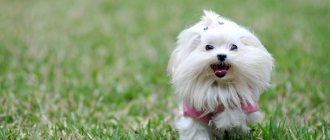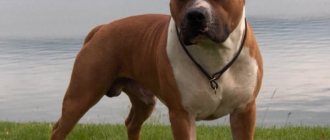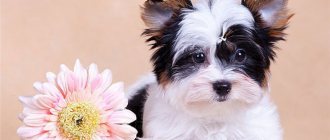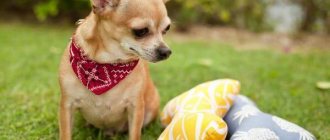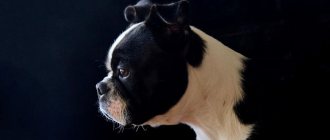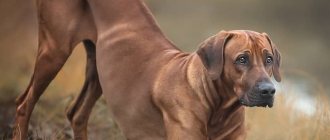The best in everything: the advantages of a beautiful Maltese
The Maltese is the oldest decorative breed. The dog is cheerful, cheerful and gives love to everyone who comes into view.
Due to its high cost, the Maltese is not adopted as often as other small dogs, such as Yorkies and toy terriers. Therefore, there are many times fewer unscrupulous owners who breed puppies just for profit.
The genotype also underwent little change. And fans of the breed have a higher chance of getting a physically and mentally healthy pet.
Many owners choose the Maltese because of its appearance. It's impossible not to fall in love with her.
A white fur coat (some dogs have an ivory shade), a miniature muzzle with black beady eyes and a button nose, aristocratic poise and refined movements can instantly win the hearts of lovers of decorative breeds.
We recommend reading: TOP 10 dogs for apartment living
Positive and negative character traits
The Maltese's sweet appearance is complemented by an almost angelic character. She has many positive traits:
- non-conflict, gets along easily with children, other dogs, cats, birds, rodents;
- playful, but in moderation - knows when to stop;
- devoted to family;
- non-aggressive - adult dogs never bite, puppies can bite, but not too much: while playing or by accident;
- Despite its good-natured nature, in a critical situation the Maltese is able to protect itself and its owner;
- not inclined to dominate, easy to train, suitable for novice dog breeders;
- senses the owner’s mood and adapts to it.
However, there are also negative aspects to the character of the Maltese dog:
- easily excitable nervous system - the Maltese is sensitive, often takes offense, can get angry or cry if it is punished or not given what it wants;
- some representatives are truly stubborn, you will have to look for a special approach to them;
- often manipulates kind-hearted owners, begging for a tasty morsel or violating prohibitions;
- very noisy - the lapdog is a watchdog by nature, she barks loudly and loudly at the slightest provocation;
- obsessive and need constant attention.
The Maltese tends to love the whole family. She is devoted to everyone and does not single out anyone in particular. This point should be taken into account if you want to get a “one owner” dog.
Some owners prefer other decorative breeds. Despite its innate playfulness, the Maltese is not very active. She quickly gets tired of active activities. And her favorite thing is to sleep not far from her owner.
Rules and features of care
Before buying a puppy, it is important to consult with a veterinarian to find out the nuances that you need to pay attention to. Not only correct, but also regular care, taking into account the recommendations, is important.
Important feature: poor cold tolerance. The pet should live in a warm room; the bedding or bed should have a soft base. When going outside in damp, cool weather, wear overalls for dogs.
Feeding the puppies
The veterinarian tells the owner the advantages and disadvantages of each type of food. Puppies are given both natural food and ready-made food for small dogs, taking into account the breed.
The best option is to buy super premium or holistic food for small dogs. Cheap food should not be taken due to its low usefulness for a growing organism. In addition to high-quality dry food for puppies from Proplan, Happy Dog, Hills, you need dog treats, vitamins, biscuits, ears and heels to strengthen chewing units.
Puppies are also fed natural food. It is important to provide a variety of types of food and ensure that the food is fresh. Feeding – 4 times, in small portions.
A Maltese puppy should receive:
- curds,
- boiled rice with turkey,
- yogurt,
- vegetables,
- Ryazhenka.
Diet of adult dogs
Diet: twice a day, medium-sized portions. A balanced diet is required so that the digestive tract does not suffer and the eyes do not become numb.
The diet of an adult lap dog should contain the following items:
- lean meat products;
- dairy products;
- fresh herbs;
- egg whites (it is allowed to give yolks only after 1.5 years);
- porridge;
- offal;
- cartilaginous components;
- sea fish almost without bones;
- vitamin supplements.
Dry and wet food for small dogs should be super premium and dietary. Products from the following companies are suitable for Maltese dogs:
- Proplan,
- Happy Dog,
- Royal Canin.
If your eyes are running, you will need to switch to super premium dry food. Low-grade foods should not be given: treatment of chronic stomach and liver problems is more expensive than high-quality food.
It is not advisable to mix natural food and dry food to avoid digestive problems.
Bathing
Snow-white fur looks untidy if the owner rarely washes the animal. The optimal interval between water procedures is 7 days. Use zoo shampoo diluted to prevent dandruff from appearing on the skin. After bathing, the fur is blotted with a soft towel and the pet is wrapped to absorb the water.
The wet wool is dried with a hairdryer and carefully combed. Do not overdry the skin or supply very hot air.
Walks
It is advisable to take the animal outside every day, but if this recommendation is not possible, the dog will tolerate the absence of daily walks quite well. The Maltese is an indoor dog; unlike the Yorkshire Terrier, it needs less long outdoor games and walking twice a day.
After walks, be sure to wash the paw pads: you must not allow an infection to enter the digestive tract with dirt particles. The coat should be trimmed if the pet prefers active games outside. Long hairs should not be allowed to drag along the ground.
It is important to choose favorable weather for walks and avoid walking your dog in windy, wet weather. Pet stores have many varieties of overalls for the autumn-winter period.
Vaccinations
Vaccination is carried out according to different schemes, taking into account the age of the pet (upon reaching at least 4 weeks). The Nobivak vaccine of several categories for the prevention of canine distemper, parovirus enteritis, viral hepatitis, and other pathologies has received positive reviews from veterinarians. Be sure to notify the veterinarian about allergic reactions and monitor the animal’s condition after vaccination. Revaccination is carried out according to the schedule.
Toys
Maltese loves balls, soft rubber hedgehogs, artificial bones, and moving objects. It is important to purchase several toys so that your pet does not get bored.
Grooming
Combing is a daily ritual. The Maltese sheds in stages, there are no sharp periods, and owners do not have to constantly remove clumps of fur. During molting, the dog noticeably loses its decorative appearance, but after restoration of the coat it again pleases with the condition of its snow-white coat.
Ear and dental care
Be sure to clean your Maltese's ears every week. The treatment is carried out carefully so as not to damage the delicate skin. Be sure to use special drops to disinfect and soften the skin.
Manufacturers offer toothbrushes for dogs. It is important to treat dental units every day and remove food particles. As you grow older, you need to visit a veterinarian to find out which paste the doctor recommends for your pet. Do not allow hard deposits to form on your teeth.
Eye care
An important procedure is daily treatment of the periocular area with tampons soaked in a nourishing balm. Soft deposits and dark streaks must not be allowed to accumulate. Be sure to examine your eyes every day to see if there are any small foreign particles.
Nail trimming
Be sure to monitor the length of the stratum corneum, especially if the dog walks outside less than it should. The procedure is delicate, it is advisable to contact a veterinary clinic.
When trimming nails on their own, the owner must act carefully, cutting off the minimum layer so as not to damage the blood vessels. To treat horny formations in dogs, special nail scissors are sold at the veterinary clinic.
Combing
To care for the fur, use a furminator glove, a comb with mild teeth made of bone or high-quality plastic. You must not allow tangles to appear. It is forbidden to pull the fur or comb uncomfortable areas with pressure, so as not to damage the skin.
Look at the description of the Brabançon dog breed, and also learn about the rules for keeping a funny dog.
Read about what to do at home if your dog is constipated and how to help your tailed friend at this address.
On the page, read the information about the first signs of piroplasmosis in dogs and methods of treating the disease.
Good health is one of the main advantages of the breed
The Maltese is a physically resilient breed. Lives 14 – 16 years. Some individuals crossed the threshold of 18 years.
The dog has a well-developed bone structure and strong immunity, which is quite rare among decorative breeds. However, the Maltese, although not often, still gets sick.
The main scourge of the charming dog is eye pathologies and dislocation of the knee joint. The most common are distichiasis, glaucoma, retinal atrophy, and disruption of the tear ducts. It is also necessary to ensure that the pet does not jump from high surfaces, especially before six months.
In addition, the Maltese is prone to:
- chronic heart disease;
- colds;
- dermatitis;
- hypoglycemia;
- deafness;
- gastrointestinal diseases;
- hydrocephalus.
A separate topic is nutrition. You cannot overfeed your dog, even a little and occasionally. No decorative breed gains weight as quickly as the Maltese.
Maintenance and care
The health of your pet directly depends on regular, according to all the rules, care . And first of all, before purchasing a puppy or an adult dog, you will need to buy everything you need to further care for them: shampoos, toothbrushes and special pastes for dogs, various combs, collars and leashes, bowls, etc.
have their teeth brushed from puppyhood . This will have to be done regularly, otherwise tartar will appear. It is best to accustom the dog to this while he is still small. Of course, such a procedure will not bring joy to the puppy, but Maltese dogs get used to it quickly.
Your dog's eyes will require special care: they must be cleaned regularly using a cotton swab moistened with eye lotion. If there are stains (usually brown or reddish) on the fur near the eye sockets, they are removed using an iron comb with small, frequent teeth.
You will also need to remove fur from your animal’s ears quite often. This is done using special ear drops, which are instilled into the ear canal, and then the dog itself will shake out what is superfluous. Then you will need to use a cotton swab to remove visible dirt from your ears, but you cannot go deeper into the ear canal - there is a high probability of causing injury.
Maltese wool
This care is rightfully considered a separate topic, and includes three mandatory stages:
- daily washing and combing, and pets of this breed can have different hairstyles,
- drying after washing must be done first with a towel, and only then with a hairdryer, and not too hot, so as not to damage the wool,
- long and careful combing after each walk.
We must remember that you can only wash your lapdog with a special shampoo for dogs. And you will definitely have to make sure that the fur does not get into your eyes . These dogs are very sensitive.
However, the dog can be cut quite short, but in such a case it will no longer be suitable for exhibitions.
Caring for show dogs
If the puppy was purchased to participate in exhibitions, then special and close attention will require caring for its coat . You will have to wash your pet much more often, at least once a week.
After this, pre-dry with a towel, and then wind the strands of wool on curlers. This is necessary so that the coat is long, thick, even in structure, and does not split.
The dog must be accustomed to this procedure from puppyhood . And to prevent your pet from taking off his curlers, you will need to purchase and put on a special silk jumpsuit.
Do not human shampoo to wash your dog ! Be sure to wash the Maltese only with dog shampoo, and in addition, you will also need conditioner from the same company.
If after washing the wool becomes tangled or tangled, under no circumstances should you cut it off! Just take it apart with your fingers while the dog is still wet.
In addition, the diet of a show dog should contain vitamins E, A, and vegetable fats, which are very beneficial for the coat.
Accommodations
Such a pet can only live in a city apartment or in a house, but not on the street. However, it will feel great in a room of any size, even a very small one. And even walks are not necessary for the Maltese, since they can easily learn to use the litter tray.
However, dogs still need fresh air. Therefore, it will be useful to walk with them at least occasionally. In addition, you can periodically ventilate the apartment, but make sure that there are no drafts . A cold is a dangerous and sometimes deadly enemy for a lapdog.
These dogs do not shed , so you don’t have to worry about the cleanliness of the house. But you will need to remove the wires from the floor, because the dog can easily get entangled in them. The same applies to sharp objects: if they are in its access zone, the Maltese may get hurt.
It is best to make the pet’s personal place And such a place should be something like a cat’s house - soft, small, cozy and clean. But you need to make sure that direct sunlight does not fall here.
Difficulty in caring for is the main disadvantage of the Maltese.
The main disadvantage in caring for a Maltese is maintaining the condition of the coat. Without proper care, the dog will become like a mongrel.
The first step on the path to an ideal coat is a complete diet with super-premium food or a balanced diet. It is important to give your pet special vitamin complexes.
To care for the coat, you will need several types of combs (with sparse and fine combs, massage), special shampoos, conditioners, and oils. Be sure to get your haircuts done by professionals. It is also necessary to constantly collect the hair on the face in ponytails so that it does not get into the eyes.
Brush your Maltese dog at least every other day. But you shouldn’t be afraid of the lengthy procedure. She has no undercoat, the hairs are soft and do not tangle. The dog hardly sheds. The only critical point is changing the puppy's coat to an adult one.
Good news for allergy and asthma sufferers - Maltese is hypoallergenic.
Otherwise, care is not complicated and standard for many breeds:
- eyes often become watery and sour, they are wiped with lotion daily and examined after each walk;
- regularly check the dog for ticks and fleas;
- claws are trimmed as they grow;
- ears and teeth are cleaned once a week with special products for dogs;
- bathe once every one and a half to two weeks;
- it is advisable to trim the hair between the paws and pluck long hairs from the ears;
- After eating, wipe the face with a damp cloth.
During hygiene procedures, special attention is paid to the areas around the eyes and genitals. Traces of discharge can ruin the snow-white fur.
We recommend reading: Should you get a dog?
Pros and cons of the breed
Maltese dogs are considered one of the most popular dogs around the world. They are smart, cheerful and active, quickly and strongly become attached to their owners, and are completely charming in appearance. However, like any other breed, these dogs have their pros and cons. And you need to know them before purchasing a puppy.
The advantages of the Maltese include:
- longevity. The minimum lifespan for a pet is 15 years. Many live longer
- non-conflict nature, which allows such animals to get along well with other pets, if any,
- good immunity, and therefore good health. A strong skeleton, which is important for such a small dog, helps to avoid fractures,
- playful disposition, the owners will not be bored, and especially children, if there are any in the family,
- fast learner. Those. there will be no problems with training, as well as learning all sorts of tricks,
- compactness. Due to its small size, the dog is very easy to move, take with you on trips, etc.
- minimal tendency to bark.
The disadvantages of lap dogs are:
- fearlessness with relatively small size and strength. Those. the dog can attack a larger animal and get hurt,
- tendency to obesity. Moreover, excess weight is gained very quickly, but only in case of poor nutrition,
- the need for careful hair care, without which tangles and lumps appear, and if the hair gets into the ears, hearing problems will begin,
- picky eating and stubbornness. Lapses can simply refuse food they don't like.
- sensitivity to extreme weather conditions.
Positive aspects of the content
In general, keeping a Maltese is not difficult. She doesn't need a lot of space and easily gets along in small apartments. All you need is a cozy place, a lounger, toys and a couple of bowls.
The advantages of keeping lapdogs include cleanliness. Often dogs themselves ask to wipe their faces after eating, obediently wait for their paws to be washed, and happily let them brush and bathe.
Another positive side is easy upbringing. Maltese is smart and tries to please family members. She quickly gets used to the toilet, is naughty only in puppyhood, and learns the rules of behavior and basic commands without any problems. It is enough to explain several times what needs to be done. If desired, she can be taught tricks.
Maltese is ideal for families with children. She is calm and non-aggressive. However, it is not worth getting a dog for a child under 10 years old. The baby does not yet know how to properly handle the animal and may injure the fragile dog.
Often the Maltese is purchased by older people and those who have little time. The dog does not need frequent and long walks. He easily learns to go to the toilet in the cat litter box. A one-hour walk once a day will be enough. And if the weather is inclement, you can skip the daily ritual.
Maltese: advantages of the breed
There are quite a lot of positive qualities that the Maltese received from nature, and it is they that make these fluffy white lap dogs so popular.
Maintenance and care
The compact pet is ideal for keeping in small spaces. Even a small room will be a huge playground for him, where he is always comfortable. The Maltese loves to walk, like all his relatives, but he can easily survive rainy or cold weather at home. If necessary, you can accustom the puppy to a tray or diaper. The Maltese dog consumes little food (due to its diminutive size), which makes food expenses a very small item. These dogs shed extremely little, because they have practically no undercoat.
The Maltese breed is considered hypoallergenic and is recommended for those who are allergic to animal fur.
Character
With such a sweet and attractive appearance, Maltese dogs are also distinguished by their very peaceful, non-conflict character. They get along without any problems in the same area with any pets, be they cats, other dogs (regardless of size), birds, rodents and even reptiles. Adults never bite, but an unintelligent puppy may, after playing too much, bite lightly.
The dog perceives strangers without the slightest aggression, seeing them not as enemies, but as friends and new playmates. The lapdog easily adapts to any unfamiliar environment and gets used to new living conditions. She is quick-witted and smart, amenable to training and training. Maltese are distinguished by a tendency to empathy, allowing them to sense the mood of their owner well. The dog can just constantly hang around, but not intrude or bother you.
Health
Provided they are purebred and properly maintained, Maltese dogs live a long time (by dog standards) - up to 14-16 years. Their health is good, their immunity is strong. Unlike many other decorative breeds, they are not burdened with any heavy genetic inheritance.
“Fly in the ointment”: what problems may arise?
Sometimes the Maltese uses its intelligence to manipulate its owner. She makes a pitiful expression on her face, refuses to obey, violates prohibitions. But this behavior only appears in a spoiled pet.
The disadvantage of the Maltese breed is spending on clothes. The dog will have to be dressed and put on shoes during the cold season. Therefore, a potential owner, when choosing a Maltese breed, should be prepared for considerable expenses.
The Maltese is considered an elite dog. It is often brought up to emphasize one’s status, wealth or position in society. But the pet is not cheap. For a pet class puppy you will have to pay at least 20 thousand rubles. And the cost of an exhibition animal can reach 80 thousand rubles.
